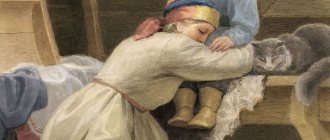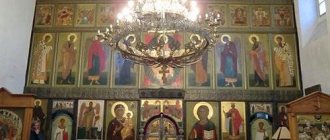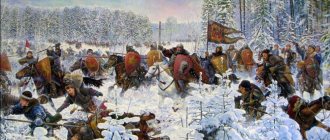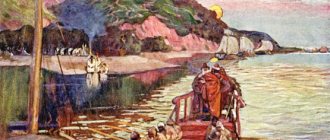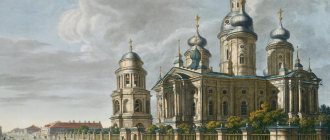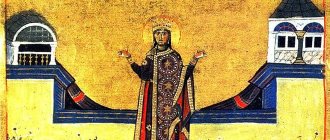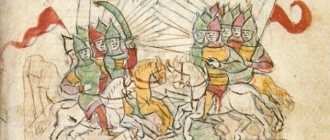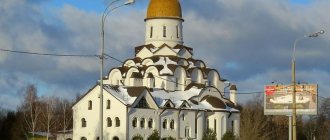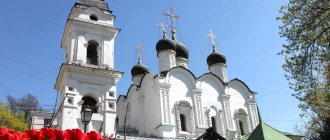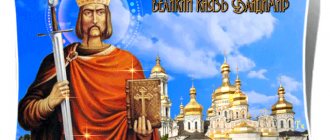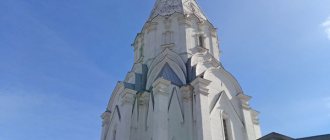The Prince Vladimir Cathedral on the Petrograd side of St. Petersburg is an active Orthodox church of the St. Petersburg diocese of the Russian Orthodox Church. The cathedral is an architectural monument, the style of which is defined by experts as transitional from Baroque to Classicism. The stone five-domed temple with a three-tiered bell tower was designed by the Italian architect Antonio Rinaldi, whose authorship is the Chinese Palace in Oranienbaum, the Marble Palace in St. Petersburg, the Great Gatchina Palace and other masterpieces that shaped the historical appearance of the northern capital and its suburbs.
Nowadays, in addition to conducting services and traditional rituals, the temple ministers are engaged in extensive educational and charitable activities. At the Cathedral of St. Equal-to-the-Apostles Prince Vladimir there is a Sunday school, a children's choir, catechisms (catechesis), lectures, master classes, pilgrimage trips, and a rich and varied community life.
© Saint-Petersburg Theological Academy
The history of the creation of the Prince Vladimir Cathedral in St. Petersburg
With the founding of St. Petersburg, a residential area was also built on the banks of the Malaya Neva. This area was often inundated during floods and the area was swampy. People called her “Mokrusha”. In 1708, here, on a swampy place, a small wooden church was built, named after St. Nicholas. In 1713, a mud-brick church was built on the same site. Its main altar was consecrated in 1719 in the presence of Peter the Great in honor of the Dormition of the Mother of God. People began to call this church “Assumption on Mokrushakh”. In its size and number of thrones, this temple was superior to others (Trinity, Peter and Paul, St. Isaac's). Therefore, it temporarily receives the status of a cathedral church.
By the 30s of the 18th century, the church had fallen into disrepair. By order of Empress Anna Ioannovna, construction of a new stone church began in 1740 (architect M. Zemtsov). Due to the death of the Empress, construction was suspended and was continued only in 1766. The architect A. Rinaldi was entrusted with completing the construction of the temple. The project has been changed. They decided to make the church five-domed, as is customary according to ancient Russian custom, and not one-domed, as previously planned.
The building was almost completed, but a fire in 1772 destroyed the old mud-brick church and damaged the new building. Completion of construction was entrusted to I.E. Starov. The temple was completed only for the 800th anniversary of the adoption of Christianity in Rus'. On October 1, 1789, the main altar of the temple was consecrated not in honor of the Dormition of the Mother of God, but in honor of Saint Prince Vladimir, the baptist of Kievan Rus. Two aisles - Uspensky and Nikolsky - remind of the old names.
On September 22, 1782, Empress Catherine II established the Order of St. Vladimir “to encourage military and civil service,” which was divided into four degrees and had the motto: “Benefit, honor and glory.” The order's ribbon consisted of three stripes: two black and a red one. Awarding the order of the fourth degree gave the right to hereditary nobility. The Order of St. Vladimir, 1st degree, followed directly from the Order of St. Andrew the First-Called, the highest award in Russia. In 1845, Emperor Nicholas I ordered that the Prince Vladimir Cathedral be designated as a temple for the Knights of the Order of St. Prince Vladimir of all degrees with the motto “Benefit, Honor and Glory.” The sign of the Order is located above the main entrance to the temple. From 1875 to 1917, there was a charitable society and an orphanage here.
Services were held in the temple during World War II and the blockade. Many city residents came here during the most terrible days for St. Petersburg. Valuable icons from closing churches were kept here. In 1935, a copy of the main shrine of the Kiev Pechersk Lavra - the icon of the Dormition of the Mother of God - was transferred here from the closed courtyard of the Lavra. One of the treasures of the temple is the Berlin Altar Gospel of 1689 in a precious frame, given by Empress Elizabeth Petrovna.
In 1946, the church's bell ringing was restored. The large bell was cast in Finland.
Schedule of services
The official website of the cathedral publishes schedules of services for the coming week, taking into account holidays, fasting and other events of the church calendar. Divine services in the Prince Vladimir Cathedral are held daily.
On weekdays : in the morning - at 9:45 o'clock - Confession; at 10:00 o'clock - Divine Liturgy; at 18:00 - Evening worship.
On Sundays and holidays:
On the eve of the holiday - All-night vigil at 18:00, confession - 17:30. The early Divine Liturgy is at 7:00 am, the late Divine Liturgy is at 10:00 am. Evening service - at 18:00.
Schedule of services at the Prince Vladimir Cathedral in St. Petersburg
© Saint-Petersburg Theological Academy
Interior decoration of the Prince Vladimir Cathedral in St. Petersburg
The interior decoration is strict and simple. There are no paintings inside the temple, except for the image of the four Evangelists. According to assumptions, the author is K. Bryullov. On the western side of the temple we see copies of the paintings “Lamentation of Christ” by Paolo Veronese and “Transfiguration” by Raphael. The walls of the temple are decorated with pilasters of the Doric order.
Since September 1940, the Kazan Icon of the Mother of God has been in the temple. On July 3, 2001, it was returned to its historical place - the Kazan Cathedral. There is now a copy in the temple in its place. On the right is the temple image of St. Prince Vladimir. The iconostasis of the temple is a masterpiece of artistic wood carving. Made in the Empire style according to the design of I.E. Starova. In the altar there is a copy of the painting of the Kyiv Vladimir Cathedral composition “Holy Eucharist” (work by V. Vasnetsov).
Architecture
The architect of the temple is the famous Italian master Antonio Rinaldi , whose other key works include the Bolshoi Theater, the Grand Palace in Gatchina, the Palace of Peter the Third and several buildings in Tsarskoye Selo and Oranienbaum.
Architecturally, the Prince Vladimir Cathedral belongs to the transitional style from Baroque to Classicism, there are also details in the Empire style
mishage8
teaser_photos
verzava
eshangina
gleb_berg
dqoxopb
peter_i_love_
In addition, until the beginning of the 21st century, the cathedral was rebuilt and completed many times : the external facade of the temple was redesigned, the chapels were moved, the iconostasis was changed, a choir, a bell tower, two chapels, and a fence appeared.
Already in the 21st century there have been several restorations, the last one in 2016. Now the cathedral is in excellent and working condition.
Patronal holidays
The Vladimir Church in St. Petersburg has 6 altars.
Each of them is dedicated to a holiday associated with the holy image, in honor of which this part of the church is consecrated:
- Since the cathedral is named Vladimir, the main patronal feast celebrated here is Candlemas. It takes place on September 8th. The event is associated with the transfer of the icon of the Vladimir Mother of God to Moscow. This happened at a difficult time for Rus', during the period of Tamerlane’s invasion of Moscow. To strengthen the spirit of the townspeople, a miraculous image was delivered to them from Vladimir. Residents of the city organized a meeting of offerings on Kuchkovo Field. The Sretensky Monastery was subsequently built here.
- November 6 marks the feast of the icon “The Joy of the Mother of All Who Sorrow.” Her throne is located in the northern limit of the upper temple. The event is associated with the deliverance from illness, thanks to the image, of the sister of Patriarch Joachim.
- September 30 marks one of the most revered holidays in Russia - Faith, Hope and Love and their mother Sophia. The girls and their mother were executed for their Christian faith. The limit dedicated to them is located in the southern part of the upper church.
- In the lower temple on the same side is the limit of the Great Martyr Charalampios. The bishop also suffered for his faith in Christ. The veneration of the saint is celebrated on February 23.
- The northern limit of the lower temple is dedicated to Saint Elijah the Prophet, who is highly revered in Russia. The day celebrated on August 2. On Elijah’s Day, a procession of the Cross takes place at the Vladimir Church. The image of the Kazan Mother of God is taken out of the Kazan Cathedral and solemnly carried along Nevsky Prospect to the Vladimir Church. The liturgy is celebrated here, and then the shrine is carried back the same way. A similar tradition appeared during the time of Catherine 2 in 1774.
- The central altar is dedicated to St. John of Damascus. Memorial Day, which is celebrated on December 17th. John of Damascus is the author of many theological works. According to legend, thanks to him the image of the Mother of God of Three Hands arose.
Many tourists who come to St. Petersburg and visit the Vladimir Church note its extraordinary atmosphere and an overwhelming sense of peace and security.
Description of the Church of St. Vladimir
Architecture
Anyone who comes to Sochi is primarily attracted by the appearance of the temple of Prince Vladimir. The main color of the facade is white, but multi-colored decorative details give it extraordinary beauty and fabulousness. Along the perimeter the walls are artistically decorated with colored patterns and volumetric overlays. At the entrances, the columns are distinguished by relief lace ornaments. In some parts, on the bell tower and above the cornices, birds of paradise sit - a symbol of rebirth to a new life. Parishioners call them “firebirds.”
Another feature of the church is the appearance of the drum. Between its windows, ceramic figures of the apostles are found, covered with multi-colored glaze. Their height is 4.5 m. Stucco six-winged seraphim stand out above the window arches.
The Temple of Vladimir in Sochi has a large helmet-shaped dome over the main room, one onion dome over the bell tower and small onions, or rather “candles” above the apse of the altar and the entrance porticoes. To add shine and durability to the dome, the altar apses and roofs were “gilded” with titanium nitride. The bell tower is connected to the temple. It contains 12 bells with a total weight of 7.5 tons. They were made by craftsmen from the Voronezh foundry "Vera". The central portal leads to the upper chapel in honor of St. book Vladimir, side - to the lower one - St. Nicholas the Wonderworker.
Interior decoration
It is not inferior to the external design. Upon entering, a person realizes that he has not entered an ordinary building, but the “house” of God. In 2016, about 30 masters of Palekh icon painting worked on painting the walls from the inside. The work was done with durable paint (taking into account the humidity of the resort) in the style of the 17th century. The painting is difficult to distinguish from a traditional fresco. The main motifs of the decoration are biblical events and scenes from the life of Prince Vladimir.
In the center there is a four-tiered carved iconostasis. It was designed by artists from the icon painting workshop of Ivan Lebedev and Alexander Gusakovsky (palekh village). The first row depicts life-size icons of princes and princesses. The masters performed their work in a canonical style, emulating the best examples of Russian icon painting. The iconostasis is richly decorated with elements of gilded carving.
The floor is decorated with marble tiles. In the summer heat it serves as an additional source of coolness; in winter it is heated, which ensures the comfort of worshipers. Under the main dome, the chandelier attracts attention; its lower part is made like the rim of a wheel (single-tier horos), where small icons are placed, and above there is a five-tier chandelier with candle lamps.
Modernity
There are many visitors here in the summer. Pilgrims come here purposefully to pray and venerate the shrines. In the temple there is an ark with parts of 12 holy saints of God. Tourists and vacationers first enter the courtyard to admire the beauty of the church, take photos against its background, and then curiosity pushes them to look at the “design” of the interior decoration. The temple area is well-groomed, ornamental plants are planted around it, and there is a parking lot. You can hide from the summer heat on benches in the shade of trees. At night, the building is beautifully illuminated with lanterns.
Shrines[edit]
- icon of the image of our Lord Jesus Christ not made by hands
- list of the Kazan Icon of the Mother of God
- list of the icon of the Mother of God “Neva Quick to Hear”
- Icon of the Mother of God “The Sign”
- icon of the Annunciation of the Blessed Virgin Mary
- icon of the Assumption of the Blessed Virgin Mary
- icon of All Saints' Day in the Russian land who have shone
- icon blgv. book Alexander Nevsky
- icon of St. Nicholas the Wonderworker
- icon of St. Nicholas the Wonderworker with the life of the saint
- icon of St. Seraphim of Sarov
- icon of St. Sergius of Radonezh
- Elizabethan altar gospel
- blockade antimens
Church history
The Vladimir Church in St. Petersburg did not immediately acquire the appearance it has now. It was completed and restored more than once. In 1737, beyond the Fontanka, the construction of new residential buildings for the court servants began, the so-called Moscow Suburb. It was planned to build a church for the population inside the settlement.
However, construction of the first of them began only in 1745. Before this, services took place in the lower floor of one of the residential buildings. The temple was erected in 1747. It was made of wood and was crowned with 1 dome. The church was consecrated in honor of the icon of Our Lady of Vladimir on August 15, and on the 16th, Elizaveta Petrovna herself attended the service. She presented the parish with a monetary gift. Many valuable gifts were received for the consecration of the church, including a list of Our Lady of Vladimir, silver utensils, and icons in expensive frames.
Over time, the building became dilapidated, and the residents petitioned the empress for permission to build a new temple. The construction project was supposedly prepared by the Swiss architect Pietro Antonio Trezzini.
Construction began in 1760. The new building was erected from stone. After 8 years, a lower warm church with 2 chapels was built and consecrated in honor of John of Damascus. Catherine II was present at the celebration. After 15 years, the upper room was completed and consecrated.
In the upper part there were chapels:
- central, dedicated to the icon of Our Lady of Vladimir;
- the southern one was consecrated in honor of the Great Martyrs Mother Sophia and 3 daughters Vera, Nadezhda and Lyubov.
- The northern one was dedicated to the icon “Joy of All Who Sorrow.”
In subsequent years, the temple space and the building itself were completed and supplemented with new elements:
| Year of construction | Name of elements |
| 1791 | A 3-tier bell tower was added to the temple according to the design of G. Quarenghi. The squat bell tower did not look next to the majestic temple because it was slightly lower than it. The 2 tiers of the bell tower were shaped like an octagon, the last tier was made in the form of a semicircular rotunda framed by Ionic columns. The bell tower ended with a flat dome. |
| 1848 | Architect F.I. Ruska added another tier. It was also made in the shape of a rotunda, but it was crowned with a high dome with a small dome and a cross. The bell tower became slimmer and harmoniously fit into the temple ensemble. Two years later Ruska F.I. added 2 more chapels and a fence to it. |
| 1816 | The entrance to the altar was made from a staircase located near the apse. |
| 1830 | Architect A. Melnikov added a new vestibule to the temple from the west. |
| 1833 | The temple now has extensions built according to the design of A.M. Golm. |
| 1864 | A large square was built around the church. |
During the construction of the temple, robbers brutally killed its rector, John Kirikov, who was collecting donations for construction. This is probably why they killed him, hoping to find money.
The clergyman is buried in the church fence. A marble monument was erected on his grave. Memorial services are traditionally held here on patronal feast days and during the procession of the Cross.
The temple was often visited by such famous figures of literature and art of St. Petersburg, who lived on the territory of the parish, as:
- Dostoevsky F.M.;
- Pushkin A.S.;
- Nekrasov N.A.;
- Rimsky-Korsakov N.A.;
- Kuprin A.I.;
- Garshin V.M.;
- Gumilev L.
Dostoevsky F.M. lived nearby and was the most diligent parishioner of the church and often visited it. The church still remembers him during services. The church website has a section dedicated to the writer.
The funeral service was held in the church for Pushkin’s nanny, Arina Rodionovna Yakovleva, and Alexander Sergeevich’s friend, Anton Delvig. Pushkin was present at both events. The poet’s parents and the family of his son-in-law N.I. lived near the temple for some time. Pavlishcheva (sister's husband).
In 1865, a charitable society was established at the church to help an orphanage and a women's almshouse. It was located in a 2-story building of the temple ensemble.
At this time the parish was one of the richest in St. Petersburg. Many of its exhibits have been shown at exhibitions more than once.
In 1932, the church was transferred to the state. It housed the collections of the Public Library, and after the war the books of the Academy of Sciences were housed. Later the building changed hands to one more owner. Knitwear production was established here.
In 1960, the church was recognized as a unique architectural monument and taken under state protection.
In 1989, the building was returned to the Russian Orthodox Church, and since 1990, divine services began to be held in it again.
Since 2000, the church has been given the status of a cathedral.
History of construction
For the first time, a temple was built in the form of a small building. It should be noted that the church was rebuilt more than once. It had different types and forms. For the first time it was consecrated in honor of St. Nicholas the Wonderworker. A little later it was rebuilt and a building with two aisles was made.
And only 30 years later it was rebuilt using brick and stone. When the temple was rebuilt again, and it had a five-domed shape, it was consecrated in honor of Prince Vladimir. It was even the main church of the prince's order. In Soviet times, when there was a fight against religiosity, the temple was not touched for some reason. He continued his work.
The best article for you, go to: Alexander Nevsky Cathedral in Novosibirsk
Work was carried out at the temple and information was collected about the victims of the Bolshevik persecution of believers. And at the end of the 90s, this information was published in a special publication.
